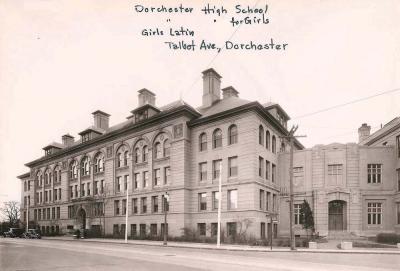October 29, 2015
 Girls' Latin School, shown above when it was housed in this Codman Square building, now used for apartments. Photos courtesy Boston City Archives; Patrick O’Connor
Girls' Latin School, shown above when it was housed in this Codman Square building, now used for apartments. Photos courtesy Boston City Archives; Patrick O’Connor
The Girls’ Latin School, which closed its doors in Codman Square in the mid- 1970s, was once a hallmark of stellar public education, alumnae recalled at a recent gathering at the Boston Public Library, one of a series of talks on local history that is being supported by the library.
Along with other former students, Karen Curran, who currently serves as president of the GLS/Boston Latin Academy Association, Inc., has actively sought to ensure that the country’s first college preparatory high school for girls continues to recognize the thousands who passed through its halls and the legacy they left behind.
Speaking in front of generations of Girls’ Latin School alums, Curran, of the Class of ‘74, discussed her book: “Her Greatness Proclaim: The History of Girls’ Latin School,” in which she tracks the school from its conception through its successful years and into the time of “its ironic demise as a casualty of the women’s movement.”
As for that legacy overall, Curran said, “We all feel extremely indebted to this education. And in talking about this book, the thing that strikes me the most is that we were afforded the opportunity to go to this public school that was as good as any private school or public school in the United States, and that was an opportunity that has diminished over the past four decades in Boston.”
Activist mothers in the 1870s were largely responsible for pushing for the establishment of girl’s educational institution that would be equivalent to that of the Boston Latin School, Curran said. An executive committee of the Massachusetts Society for the University Education of Women first sought unsuccessfully to have girls granted admittance to the male-only Latin School. Then, after an arduous procession of petitions and board referrals, Girls’ Latin School, the first of its kind in the country, opened on West Newton Street in Boston’s South End on Feb. 12, 1878, with 37 pupils split among three classes.
As the school grew in size and renown, it moved: first to Copley Square in 1898, then to a shared building on Huntington Avenue in the Fenway in 1907. When the Teachers’ College, with whom GLS shared the building, expanded, Girls Latin relocated in 1955 to the former Dorchester High School for Girls building in Codman Square. That building, with its familiar yellow edifice, is now an apartment complex.
Angelika Angino, of the class of ‘69, recalled that it took her more than an hour to travel from her home in South Boston to the Codman Square schoolhouse. And every night, she said, they all buckled down to hours of homework, often until midnight, she said.
On her first day, she said, “I’ll never forget sitting in homeroom; one of the first things we heard was...eight girls achieved perfect 800s on their SATs. That was how we started.” Shaking her head, she added, “The bar was set so high that you never thought you could reach that far.”
Angino, Kathy Hinderhofer, and another friend who graduated with them in 1969, were in attendance at the Oct. 21 event. Twelve years after they left, the Codman Square building sat vacant in Codman Square, GLS classes having been transferred in 1981 to a former post office warehouse on Ipswich Street in the Fenway.
As the women’s movement rolled through the country, in 1971, the Legislature passed a law ending gender discrimination in the two Latin Schools. Male students were admitted in 1972, and the school name was changed to Boston Latin Academy three years later. A final move settled the school its current location, on Townsend Street in Dorchester, where the enrollment this year is put at just under 1,800 students.
Alumnae still have mixed feelings about making the school co-ed. “The importance of single-sex education was irreplaceable,” Hinderhofer said, joking that “the only time you really heard about boys was when you needed a date for the prom.” And the caliber of the school’s academics, “gives you a confidence that you are equal to anyone who was educated at Boston Latin School,” she said.
At BLA, there are vestiges of the former female educational powerhouse. The school paper and its sigil from 1888, the Jabberwock, is referred to today as a dragon, but the original shape of the creature remains prominently featured on the school crest.


